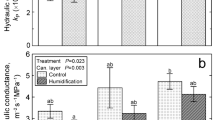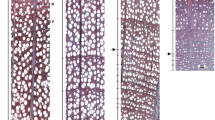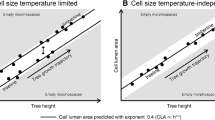Abstract
Key message
The xylem anatomical structure of Betula pendula is conservative regarding changes in atmospheric humidity, but it is plastic along the vertical canopy profile to optimise water supply among different foliage layers.
We studied responses of wood anatomical traits in silver birch (Betula pendula) to artificially elevated air humidity to simulate a climate trend predicted for northern latitudes. The study was performed on saplings growing at Free Air Humidity Manipulation (FAHM) site, eastern Estonia, with the long-term mean relative air humidity (RH) increased by 7% over the ambient level. The humidification treatment did not significantly affect xylem traits or specific hydraulic conductivity, confirming a conservative nature of the wood anatomical structure with respect to air humidity. Only wood density decreased in response to elevated RH. The reduced atmospheric evaporative demand had a weak effect on the development of the plant water-conducting system in moderately humid climates in the northern temperate zone under conditions of ample soil water availability. The wood anatomical traits of both branches and main stems varied substantially with canopy position, with larger height effects in main stems. In main stems, vessel hydraulic diameter and theoretical (kt) and specific conductivities (ks) of the xylem decreased in the apical direction. In contrast, upper-crown branches had wider vessels and a bigger vessel relative area that resulted in kt and ks both increasing from the crown base upward. Vessel size and xylem hydraulic efficiency were positively associated with radial growth rate of stems.






Similar content being viewed by others
References
Aloni R (2015) Ecophysiological implications of vascular differentiation and plant evolution. Trees 29:1–16
Aloni R, Zimmermann MH (1983) The control of vessel size and density along the plant axis. Differentiation 24:203–208
Anderson G, Bancroft J (2002) Tissue processing and microtomy including frozen. In: Bancroft J, Gamble JD (eds) Theory and practice of histological techniques. Churchill Livingstone, London, pp 87–107
Anfodillo T, Deslauriers A, Menardi R, Tedoldi L, Petit G, Rossi S (2012) Widening of xylem conduits in a conifer tree depends on the longer time of cell expansion downwards along the stem. J Exp Bot 63:837–845
Anfodillo T, Petit G, Crivellaro A (2013) Axial conduit widening in woody species: a still neglected anatomical pattern. IAWA J 34:352–364
Arbellay E, Fonti P, Stoffel M (2012) Duration and extension of anatomical changes in wood structure after cambial injury. J Exp Bot 63:3271–3277
Bettiati D, Petit G, Anfodillo T (2012) Testing the equi-resistance principle of the xylem transport system in a small ash tree: empirical support from anatomical analyses. Tree Physiol 32:171–177
Brodribb TJ, Holbrook NM, Gutierrez MV (2002) Hydraulic and photosynthetic co-ordination in seasonally dry tropical forest trees. Plant Cell Environ 25:1435–1444
Cai J, Zhang S, Tyree MT (2010) A computational algorithm addressing how vessel length might depend on vessel diameter. Plant Cell Environ 33:1234–1238
Carlquist S (2001) Comparative wood anatomy: systematic, ecological, and evolutionary aspects of dicotyledon wood. Springer, Berlin
Carrer M, von Arx G, Castagneri D, Petit G (2015) Distilling allometric and environmental information from time series of conduit size: the standardization issue and its relationship to tree hydraulic architecture. Tree Physiol 35:27–33
Chave J, Coomes D, Jansen S, Lewis SL, Swenson NG, Zanne AE (2009) Towards a worldwide wood economics spectrum. Ecol Lett 12:351–366
Choat B, Sack L, Holbrook NM (2007) Diversity of hydraulic traits in nine Cordia species growing in tropical forests with contrasting precipitation. New Phytol 175:686–698
Cochard H (2006) Cavitation in trees. C R Phys 7:1018–1026
Coomes DA, Heathcote S, Godfrey ER, Shepherd JJ, Sack L (2008) Scaling of xylem vessels and veins within the leaves of oak species. Biol Lett 4:302–306
Creese C, Benscoter AM, Maherali H (2011) Xylem function and climate adaptation in Pinus. Am J Bot 98:1437–1445
Dai A (2006) Recent climatology, variability, and trends in global surface humidity. J Clim 19:3589–3606
De Micco V, Aronne G, Baas P (2008) Wood anatomy and hydraulic architecture of stems and twigs of some Mediterranean trees and shrubs along a mesic-xeric gradient. Trees 22:643–655
Fan ZX, Cao KF, Becker P (2009) Axial and radial variations in xylem anatomy of angiosperm and conifer trees in Yunnan, China. IAWA J 30:1–13
Fan ZX, Zhang SB, Hao GY, Ferry Slik JW, Cao KF (2012) Hydraulic conductivity traits predict growth rates and adult stature of 40 Asian tropical tree species better than wood density. J Ecol 100:732–741
Fernandez ME, Gyenge JE, de Urquiza MM, Varela S (2012) Adaptability to climate change in forestry species: drought effects on growth and wood anatomy of ponderosa pines growing at different competition levels. Forest Syst 21:162–173
Fichot R, Laurans F, Monclus R, Moreau A, Pilate G, Brignolas F (2009) Xylem anatomy correlates with gas exchange, water-use efficiency and growth performance under contrasting water regimes: evidence from Populus deltoides × Populus nigra hybrids. Tree Physiol 29:1537–1549
Goulet J, Messier C, Nikinmaa E (2000) Effect of branch position and light availability on shoot growth of understory sugar maple and yellow birch saplings. Can J Bot 78:1077–1085
Hajek P, Leuschner C, Hertel D, Delzon S, Schuldt B (2014) Trade-offs between xylem hydraulic properties, wood anatomy and yield in Populus. Tree Physiol 34:744–756
Hietz H, Rosner S, Hietz-Seifert U, Wright J (2017) Wood traits related to size and life history of trees in a Panamanian rainforest. New Phytol 213:170–180
Hoeber S, Leuschnera C, Köhler L, Arias-Aguilar D, Schuldt B (2014) The importance of hydraulic conductivity and wood density to growth performance in eight tree species from a tropical semi-dry climate. For Ecol Manage 330:126–136
IPCC (2013) Climate change 2013: the physical science basis. Cambridge University Press, Cambridge
Islam M, Rahman M, Bräuning A (2018) Long-term hydraulic adjustment of three tropical moist forest tree species to changing climate. Front Plant Sci 9:1761. https://doi.org/10.3389/fpls.2018.01761
Jasińska AK, Alber M, Tullus A, Rahi M, Sellin A (2015) Impact of elevated atmospheric humidity on anatomical and hydraulic traits of xylem in hybrid aspen. Funct Plant Biol 42:565–578
Kotowska MM, Hertel D, Rajab YA, Barus H, Schuldt B (2015) Patterns in hydraulic architecture from roots to branches in six tropical tree species from cacao agroforestry and their relation to wood density and stem growth. Front Plant Sci 6:191. https://doi.org/10.3389/fpls.2015.00191
Kupper P, Sõber J, Sellin A, Lõhmus K, Tullus A, Räim O, Lubenets K, Tulva I, Uri V, Zobel M, Kull O, Sõber A (2011) An experimental facility for free air humidity manipulation (FAHM) can alter water flux hrough deciduous tree canopy. Environ Exp Bot 72:432–438
Lewis AM, Boose ER (1995) Estimating volume flow rates through xylem conduits. Am J Bot 82:1112–1116
Li X, Blackman CJ, Choat B, Duursma RA, Rymer PD, Medlyn BE, Tissue DT (2018) Tree hydraulic traits are coordinated and strongly linked to climate-of-origin across a rainfall gradient. Plant Cell Environ 4:646–660
Liu H, Gleason SM, Hao G, Hua L, He P, Goldstein G, Ye Q (2019) Hydraulic traits are coordinated with maximum plant height at the global scale. Sci Adv 5(2):eaav1332. https://doi.org/10.1126/sciadv.aav1332
Loepfe L, Vilalta-Martinez J, Pinol J, Mencuccini M (2007) The relevance of xylem network structure for plant hydraulic efficiency and safety. J Theor Biol 247:788–803
Longui EL, Romeiro D, Testoni LN, de Aguiar OT, Filho RC, de Lima IL, Florsheim SMB (2012) Water deficit affects wood vessels of Croton floribundus Spreng. in different vegetation types, São Paulo State, Brazil. Hoehnea 39:113–123
López-Bernal Á, Alcántara E, Testi L, Villalobos JF (2010) Spatial sap flow and xylem anatomical characteristics in olive trees under different irrigation regimes. Tree Physiol 30:1536–1544
Martıńez-Cabrera HI, Schenk HJ, Cevallos-Ferriz RS, Jones CS (2011) Integration of vessel traits, wood density, and height in angiosperm shrubs and trees. Am J Bot 98:915–922
Martínez-Cabrera HI, Jones CS, Espino S, Schenk HJ (2009) Wood anatomy and wood density in shrubs: responses to varying aridity along transcontinental transects. Am J Bot 96:1388–1398
McCulloh KA, Johnson DM, Meinzer FC, Voelker SL, Lachenbruch B, Dome JC (2012) Hydraulic architecture of two species differing in wood density: opposing strategies in co-occurring tropical pioneer trees. Plant Cell Environ 35:116–125
Meinzer FC, McCulloh KA, Lachenbruch B, Woodruff DR, Johnson DM (2010) The blindmen and the elephant: the impact of context and scale in evaluating conflicts between plant hydraulic safety and efficiency. Oecologia 164:287–296
Mencuccini M, Höltta T, Petit G, Magnani F (2007) Sanio’s laws revisited. Size-dependent changes in the xylem architecture of trees. Ecol Lett 10:1084–1093
Nardini A, Dimasi F, Klepsch M, Jansen S (2012) Ion-mediated enhancement of xylem hydraulic conductivity in four Acer species: relationships with ecological and anatomical features. Tree Physiol 32:1434–1441
Nijsse J, Van der Heijden GWAM, Van Ieperen W, Keijzer CJ, Van Meeteren U (2001) Xylem hydraulic conductivity related to conduit dimensions along chrysanthemum stems. J Exp Bot 52:319–327
Oksanen E, Lihavainen J, Keinänen M, Keski-Saari S, Kontunen-Soppela S, Sellin A, Sõber A (2019) Northern forest trees under increasing atmospheric humidity. In: Matyssek R, Lüttge U, Ramos FMC (eds) Progress in botany, vol 80. Springer, Berlin, pp 317–336. https://doi.org/10.1007/124_2017_15
Oladi R, Bräuning A, Pourtahmasi K (2014) ‘‘Plastic’’ and ‘‘static’’ behavior of vessel-anatomical features in Oriental beech (Fagus orientalis Lipsky) in view of xylem hydraulic conductivity. Trees 28:493–502
Olson ME, Rosell JA (2013) Vessel diameter–stem diameter scaling across woody angiosperms and the ecological causes of xylem vessel diameter variation. New Phytol 197:1204–1213
Pérez-de-Lis G, Rossi S, Vázquez-Ruiz RA, Rozas V, García-González I (2016) Do changes in spring phenology affect earlywood vessels? Perspective from the xylogenesis monitoring of two sympatric ring-porous oaks. New Phytol 209:521–530
Petit G, Anfodillo T (2009) Plant physiology in theory and practice: an analysis of the WBE model for vascular plants. J Theor Biol 259:1–4
Petit G, Crivellaro A (2014) Comparative axial widening of phloem and xylem conduits in small woody plants. Trees 28:915–921
Petit G, Anfodillo T, De Zan C (2009) Degree of tapering of xylem conduits in stems and roots of small Pinus cembra and Larix decidua trees. Botany 87:501–508
Petit G, Pfautsch S, Anfodillo T, Adams MA (2010) The challenge of tree height in Eucalyptus regnans: when xylem tapering overcomes hydraulic resistance. New Phytol 187:1146–1153
Petit G, Savi T, Consolini M, Anfodillo T, Nardini A (2016) Interplay of growth rate and xylem plasticity for optimal coordination of carbon and hydraulic economies in Fraxinus ornus trees. Tree Physiol 36:1310–1319
Pfautsch S, Harbusch M, Wesolowski A, Smith R, Macfarlane C, Tjoelker MG, Reich PB, Adams MA (2016) Climate determines vascular traits in the ecologically diverse genus Eucalyptus. Ecol Lett 19:240–248
Pichard WP, Melcher PJ (2005) Perspectives on the biophysics of xylem transport. In: Holbrook NM, Zwieniecki MA (eds) Vascular Transport in Plants. Elsevier Academic Press, Amsterdam, pp 3–18
Poorter L, McDonald I, Alarcón A, Fichtler E, Licona JC, Peña-Claros M, Sterck F, Villegas Z, Sass-Klaassen U (2010) The importance of wood traits and hydraulic conductance for the performance and life history strategies of 42 rainforest tree species. New Phytol 185:481–492
Santiago LS, De Guzman ME, Baraloto C, Vogenberg JE, Brodie M, Hérault B, Fortunel C, Bonal D (2018) Coordination and trade-offs among hydraulic safety, efficiency and drought avoidance traits in Amazonian rainforest canopy tree species. New Phytol 218:1015–1024
Scholz A, Rabaey D, Stein A, Cochard H, Smets E, Jansen J (2013) The evolution and function of vessel and pit characters with respect to cavitation resistance across 10 Prunus species. Tree Physiol 33:684–694
Schuldt B, Leuschner C, Brock N, Horna V (2013) Changes in wood density, wood anatomy and hydraulic properties of the xylem along the root-to-shoot flow path in tropical rainforest trees. Tree Physiol 33:161–174
Sellin A, Kupper P (2005) Effects of light availability versus hydraulic constraints on stomatal responses within a crown of silver birch. Oecologia 142:388–397
Sellin A, Lubenets K (2010) Variation of transpiration within a canopy of silver birch: effect of canopy position and daily versus nightly water loss. Ecohydrology 3:467–477
Sellin A, Rohejärv A, Rahi M (2008) Distribution of vessel size, vessel density and xylem conducting efficiency within a crown of silver birch (Betula pendula). Trees 22:205–216
Sellin A, Eensalu E, Niglas A (2010a) Is distribution of hydraulic constraints within tree crowns reflected in photosynthetic water-use efficiency? An example of Betula pendula. Ecol Res 25:173–183
Sellin A, Õunapuu E, Karusion A (2010b) Experimental evidence supporting the concept of light-mediated modulation of stem hydraulic conductance. Tree Physiol 30:1528–1535
Sellin A, Tullus A, Niglas A, Õunapuu E, Karusion A, Lõhmus K (2013) Humidity-driven changes in growth rate, photosynthetic capacity, hydraulic properties and other functional traits in silver birch (Betula pendula). Ecol Res 28:523–535
Sellin A, Rosenvald K, Õunapuu-Pikas E, Tullus A, Ostonen I, Lõhmus K (2015) Elevated air humidity affects hydraulic traits and tree size but not biomass allocation in young silver birches (Betula pendula). Front Plant Sci 6:860. https://doi.org/10.3389/fpls.2015.00860
Sellin A, Alber M, Keinänen M, Kupper P, Lihavainen J, Lõhmus K, Oksanen E, Sõber A, Sõber J, Tullus A (2017a) Growth of northern deciduous trees under increasing atmospheric humidity: possible mechanisms behind the growth retardation. Reg Environ Chang 17:135–2148
Sellin A, Alber M, Kupper P (2017b) Increasing air humidity influences hydraulic efficiency but not functional vulnerability of xylem in hybrid aspen. J Plant Physiol 219:28–36
Sellin A, Taneda H, Alber M (2019) Leaf structural and hydraulic adjustment with respect to air humidity and canopy position in silver birch (Betula pendula). J Plant Res 132:369–381
Sperry JS, Nichols KL, Sullivan JEM, Eastlack SE (1994) Xylem embolism in ring-porous, diffuse-porous, and coniferous trees of northern Utah and interior Alaska. Ecology 75:1736–1752
Sperry JS, Hacke UG, Wheeler JK (2005) Comparative analysis of end wall resistivity in xylem conduits. Plant Cell Environ 28:456–465
West GB, Brown JH, Enquist BJ (1999) A general model for the structure and allometry of plant vascular systems. Nature 400:664–667
Wheeler JK, Sperry JS, Hacke UG, Hoang N (2005) Inter-vessel pitting and cavitation in woody Rosaceae and other vesselled plants: a basis for a safety versus efficiency trade-off in xylem transport. Plant Cell Environ 28:800–812
Zhang SB, Cao KF, Fan ZX, Zhang JL (2013) Potential hydraulic efficiency in angiosperm trees increases with growth-site temperature but has no trade-off with mechanical strength. Glob Ecol Biogeogr 22:971–981
Zhao X (2016) Spatial variation of vessel grouping in the xylem of Betula platyphylla Roth. J Plant Res 129:29–37
Zhu SD, Song JJ, Li RH, Ye Q (2013) Plant hydraulics and photosynthesis of 34 woody species from different successional stages of subtropical forests. Plant Cell Environ 36:879–891
Acknowledgements
This study was supported by the Estonian Ministry of Education and Research (institutional research project IUT34-9). We are grateful to Dr. Ants Kaasik for his assistance with statistical data analysis.
Author information
Authors and Affiliations
Corresponding author
Ethics declarations
Conflict of interest
The authors declare that they have no conflict of interest.
Additional information
Communicated by Sano.
Publisher's Note
Springer Nature remains neutral with regard to jurisdictional claims in published maps and institutional affiliations.
Electronic supplementary material
Below is the link to the electronic supplementary material.
Rights and permissions
About this article
Cite this article
Alber, M., Petit, G. & Sellin, A. Does elevated air humidity modify hydraulically relevant anatomical traits of wood in Betula pendula?. Trees 33, 1361–1371 (2019). https://doi.org/10.1007/s00468-019-01863-0
Received:
Accepted:
Published:
Issue Date:
DOI: https://doi.org/10.1007/s00468-019-01863-0




